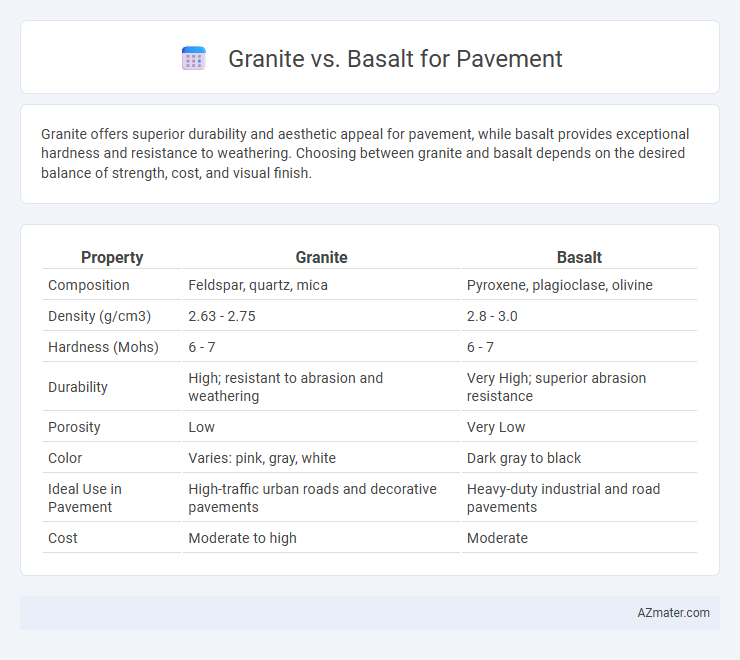Granite offers superior durability and aesthetic appeal for pavement, while basalt provides exceptional hardness and resistance to weathering. Choosing between granite and basalt depends on the desired balance of strength, cost, and visual finish.
Table of Comparison
| Property | Granite | Basalt |
|---|---|---|
| Composition | Feldspar, quartz, mica | Pyroxene, plagioclase, olivine |
| Density (g/cm3) | 2.63 - 2.75 | 2.8 - 3.0 |
| Hardness (Mohs) | 6 - 7 | 6 - 7 |
| Durability | High; resistant to abrasion and weathering | Very High; superior abrasion resistance |
| Porosity | Low | Very Low |
| Color | Varies: pink, gray, white | Dark gray to black |
| Ideal Use in Pavement | High-traffic urban roads and decorative pavements | Heavy-duty industrial and road pavements |
| Cost | Moderate to high | Moderate |
Understanding Granite and Basalt: Key Differences
Granite is an intrusive igneous rock composed mainly of quartz, feldspar, and mica, known for its coarse-grained texture and high durability, making it ideal for high-traffic pavement areas. Basalt, an extrusive igneous rock formed from rapid cooling of lava, features a fine-grained texture and high density, providing excellent compressive strength and wear resistance suited for heavy load pavement applications. Key differences include granite's slower cooling process resulting in larger crystals and enhanced aesthetic appeal, while basalt's rapid cooling produces a more uniform structure with superior resistance to weathering and abrasion.
Geological Formation and Composition
Granite, an intrusive igneous rock, forms from the slow cooling of magma deep within the Earth's crust, resulting in a coarse-grained texture primarily composed of quartz, feldspar, and mica. Basalt is an extrusive igneous rock that cools rapidly at the surface from lava flows, characterized by a fine-grained texture rich in pyroxene and plagioclase minerals. The differing geological formation processes influence their durability and wear resistance, with granite's interlocking crystals offering greater strength for pavement applications compared to basalt.
Physical Properties Essential for Pavements
Granite features high compressive strength around 130-200 MPa and excellent abrasion resistance, making it durable for heavy traffic pavement applications. Basalt offers superior density and impact resistance, with compressive strength typically between 100-300 MPa, which enhances load-bearing capacity and longevity in road surfaces. The thermal expansion coefficient of granite is lower than basalt, reducing crack formation under temperature variations, crucial for pavement durability.
Durability and Longevity Comparison
Granite offers exceptional durability and resistance to abrasion, making it ideal for high-traffic pavement areas with a lifespan exceeding 50 years. Basalt, known for its dense and fine-grained structure, provides superior strength and weather resistance, often outperforming granite in freeze-thaw cycles and maintaining integrity in harsh climates. Both stones excel in longevity, but basalt's natural toughness and lower porosity contribute to enhanced pavement durability under extreme conditions.
Load-Bearing Capacity of Granite vs Basalt
Granite exhibits a higher load-bearing capacity than basalt, making it more suitable for pavements subjected to heavy traffic and significant weight loads. The dense, coarse-grained structure of granite provides superior compressive strength and durability compared to the finer-grained basalt. While basalt offers good resistance to abrasion and weathering, granite's mechanical properties make it the preferred choice for high-load pavement applications.
Weather Resistance and Thermal Performance
Granite offers superior weather resistance due to its dense, crystalline structure, making it highly resistant to freeze-thaw cycles and chemical erosion compared to basalt. Basalt exhibits excellent thermal performance with a higher thermal conductivity, which helps dissipate heat quickly, reducing pavement surface temperature during hot weather. Both stones provide durability, but granite's low porosity enhances its longevity in harsh climates, while basalt's rapid heat diffusion aids in minimizing thermal expansion stress.
Maintenance Requirements and Lifespan
Granite pavements exhibit superior durability with a lifespan often exceeding 50 years, requiring minimal maintenance due to their high resistance to abrasion and weathering. Basalt pavements, while also durable with a lifespan around 30 to 40 years, may demand more frequent sealing and repairs to address surface wear and potential cracking under heavy traffic conditions. Both materials withstand harsh climates, but granite's lower porosity results in reduced water absorption, leading to less maintenance over time compared to basalt.
Aesthetic Appeal and Design Flexibility
Granite offers a wide range of colors and natural patterns, making it ideal for creating visually striking pavements with diverse design options. Basalt's fine-grained, uniform texture provides a sleek, modern look but with fewer color variations, limiting aesthetic versatility. Granite's durability combined with its rich palette enhances design flexibility, whereas basalt is preferred for minimalist, contemporary pavement designs.
Cost Analysis: Granite vs Basalt
Granite pavement typically costs more upfront due to its higher quarrying and processing expenses, averaging $8-$12 per square foot compared to basalt's $6-$10 per square foot. Basalt offers cost-efficiency benefits over time because of its superior durability and resistance to wear, reducing maintenance and replacement expenses. When evaluating total lifecycle costs, basalt often presents a more economical option for high-traffic pavement applications despite similar initial price ranges.
Choosing the Right Stone for Pavement Applications
Granite offers exceptional durability and resistance to abrasion, making it ideal for high-traffic pavement areas requiring long-lasting performance. Basalt features a finer grain and is naturally slip-resistant, which enhances safety in wet conditions and is suitable for decorative paving projects. Selecting between granite and basalt depends on factors like expected traffic load, aesthetic preferences, maintenance requirements, and environmental exposure to ensure optimal pavement performance.

Infographic: Granite vs Basalt for Pavement
 azmater.com
azmater.com